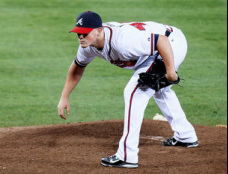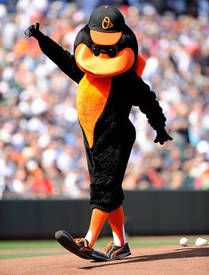At last, here are the top 3 prospects in baseball, with statistics and advanced scouting reports on each player. Hope you enjoyed the rankings as much as I did, and I will certainly try to include some prospect pieces in the near future. Later today, I will put up my top 100 prospects (without scouting reports) and my top farm systems in the game. Enjoy
3. Wil Myers , OF, Kansas City Royals, ETA: 2013:
2012 Levels: AA Northwest Arkansas (35 games), AAA Omaha (99 games)
2012 Numbers: Batted combined .314/.387/.600, with 26 2Bs, 37 HRs, 109 RBI
Baseball America's Player of the Year, Wil Myers broke out in a big way in 2012. After batting .254/.353/..393 in an injury plagued 2011, Myers showcased his power bat across the top two levels in the Royals minor league system. Myers has a strong body that generates easy plus power and also shows an advanced hitting ability that produces frequent loud contact. After being drafted as a catcher, Myers has transitioned well to the outfield, seeing time in both center field and right field. His strong arm, along with average range and jumps, should push him to right field within the next year or two. Currently, Jeff Francoeur is blocking Myers, but he should not stop the Royals from having Myers as their opening day right fielder.
2. Dylan Bundy , SP, Baltimore Orioles, ETA: 2013:
2012 Levels: A Delmarva (30 innings), High-A Frederick (57 innings), AA Bowie (16.2 innings), MLB Baltimore (1.2 innings)
2012 Numbers (Minors): 103.2 innings pitched, 2.08 ERA, 28 BB (2.4 BB/9), 119 K (10.3 K/9)
Bundy is a scout's dream for a pitcher. One of the most polished prep pitchers in recent memory and one of the best work ethics in the minors, Bundy more than lived up to the lofty expectations placed on him by dominating in his first professional season. Just during his stint with low-A Delmarva (30 innings), he struck out 40, walked two, allowed only 5!!! hits, and did not concede a single earned run. Bundy's repertoire includes a big time fastball that sits in the mid 90's while occasionally touching triple digits and also features good movement and sink. Additionally, he features a plus-plus curve (just ask Orlando Calixte), and potential plus changeup that is extremely advanced for his age. As if he could not be any better, he has very good control while his command inside the strike zone is still improving. Also, he has put up these numbers despite the Orioles refusing to let him throw his best pitch, the cutter. He will probably start the year in the minors, but should certainly see time in the big leagues at some point during the season. Bundy is the real deal and believe the hype.
1. Jurickson Profar , SS/2B, Texas Rangers, ETA: 2013:
2012 Levels: AA Frisco (126 games), MLB Texas (9 games)
2012 Numbers: Batted combined .278/.366/.455, 28 2Bs, 15 HRs, and 16 SBs
And the number one prospect in baseball is… Rangers shortstop, Jurickson Profar. A Little League World Series hero for his native Curacao, Profar was initially desired as a pitcher but the Rangers conceded and let him play his preferred position of shortstop. Just as Bundy is the ideal pitcher, Profar is about as good as it gets for a shortstop. Profar, a switch hitter, combines a plus hitting ability from both sides of the plate (although he is stronger with his more natural right side) and has a mature approach at the plate. He uses the entire field and has a line drive stroke that should allow him to hit for a high average and could be an eventual 70 or elite tool. Although he currently has only modest power, he could eventually grow into 20-25+ HR power with at least plenty of 2Bs.
Defensively, he makes the most of his strong arm (clocked as high as 95 mph off the mound) with tremendous accuracy to boot. In addition, he has very good range despite his average speed and his baseball instincts rank among the best in the minors. His makeup is off-the-charts as he is extremely mature, confident, and maximizes his talents. Just surviving against much older competition in double-A would have been considered a success, but ended up being the league's best shortstop and prospect. Considering Profar's near readiness for the majors, the Rangers have an interesting problem on their hands. All Star shortstop and Profar's idol, Elvis Andrus, is currently blocking him, and second basemen Ian Kinsler just signed an extension earlier this year. One possible solution is to let free agent Josh Hamilton walk, and move the brittle Ian Kinsler to the outfield and implant Profar as the starting second baseman. Whatever the decision, Profar should be in the majors at some point in 2013, and could be the game's best shortstop by 2015.
3. Wil Myers , OF, Kansas City Royals, ETA: 2013:
2012 Levels: AA Northwest Arkansas (35 games), AAA Omaha (99 games)
2012 Numbers: Batted combined .314/.387/.600, with 26 2Bs, 37 HRs, 109 RBI
Baseball America's Player of the Year, Wil Myers broke out in a big way in 2012. After batting .254/.353/..393 in an injury plagued 2011, Myers showcased his power bat across the top two levels in the Royals minor league system. Myers has a strong body that generates easy plus power and also shows an advanced hitting ability that produces frequent loud contact. After being drafted as a catcher, Myers has transitioned well to the outfield, seeing time in both center field and right field. His strong arm, along with average range and jumps, should push him to right field within the next year or two. Currently, Jeff Francoeur is blocking Myers, but he should not stop the Royals from having Myers as their opening day right fielder.
2. Dylan Bundy , SP, Baltimore Orioles, ETA: 2013:
2012 Levels: A Delmarva (30 innings), High-A Frederick (57 innings), AA Bowie (16.2 innings), MLB Baltimore (1.2 innings)
2012 Numbers (Minors): 103.2 innings pitched, 2.08 ERA, 28 BB (2.4 BB/9), 119 K (10.3 K/9)
Bundy is a scout's dream for a pitcher. One of the most polished prep pitchers in recent memory and one of the best work ethics in the minors, Bundy more than lived up to the lofty expectations placed on him by dominating in his first professional season. Just during his stint with low-A Delmarva (30 innings), he struck out 40, walked two, allowed only 5!!! hits, and did not concede a single earned run. Bundy's repertoire includes a big time fastball that sits in the mid 90's while occasionally touching triple digits and also features good movement and sink. Additionally, he features a plus-plus curve (just ask Orlando Calixte), and potential plus changeup that is extremely advanced for his age. As if he could not be any better, he has very good control while his command inside the strike zone is still improving. Also, he has put up these numbers despite the Orioles refusing to let him throw his best pitch, the cutter. He will probably start the year in the minors, but should certainly see time in the big leagues at some point during the season. Bundy is the real deal and believe the hype.
1. Jurickson Profar , SS/2B, Texas Rangers, ETA: 2013:
2012 Levels: AA Frisco (126 games), MLB Texas (9 games)
2012 Numbers: Batted combined .278/.366/.455, 28 2Bs, 15 HRs, and 16 SBs
And the number one prospect in baseball is… Rangers shortstop, Jurickson Profar. A Little League World Series hero for his native Curacao, Profar was initially desired as a pitcher but the Rangers conceded and let him play his preferred position of shortstop. Just as Bundy is the ideal pitcher, Profar is about as good as it gets for a shortstop. Profar, a switch hitter, combines a plus hitting ability from both sides of the plate (although he is stronger with his more natural right side) and has a mature approach at the plate. He uses the entire field and has a line drive stroke that should allow him to hit for a high average and could be an eventual 70 or elite tool. Although he currently has only modest power, he could eventually grow into 20-25+ HR power with at least plenty of 2Bs.
Defensively, he makes the most of his strong arm (clocked as high as 95 mph off the mound) with tremendous accuracy to boot. In addition, he has very good range despite his average speed and his baseball instincts rank among the best in the minors. His makeup is off-the-charts as he is extremely mature, confident, and maximizes his talents. Just surviving against much older competition in double-A would have been considered a success, but ended up being the league's best shortstop and prospect. Considering Profar's near readiness for the majors, the Rangers have an interesting problem on their hands. All Star shortstop and Profar's idol, Elvis Andrus, is currently blocking him, and second basemen Ian Kinsler just signed an extension earlier this year. One possible solution is to let free agent Josh Hamilton walk, and move the brittle Ian Kinsler to the outfield and implant Profar as the starting second baseman. Whatever the decision, Profar should be in the majors at some point in 2013, and could be the game's best shortstop by 2015.



 RSS Feed
RSS Feed